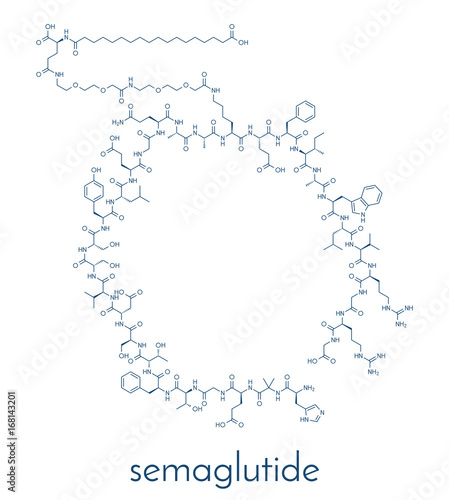Oral semaglutide shows superior improvement in HbA1c vs empagliflozin in the PIONEER 2 trial
Bagsværd, Denmark, 29 May 2018 - Novo Nordisk today announced the headline results from PIONEER 2, the second phase 3a trial with oral semaglutide for treatment of adults with type 2 diabetes. Oral semaglutide is a new GLP-1 analogue taken once daily as a tablet. The 52-week, open label trial investigated the efficacy and safety of 14 mg oral semaglutide compared with 25 mg empagliflozin in 816 people with type 2 diabetes, inadequately controlled on metformin. The confirmatory endpoints were defined after 26 weeks of treatment.
Two distinct statistical approaches to evaluating the effects of oral semaglutide were applied in the PIONEER 2 trial; a primary statistical approach[1] required by recent regulatory guidance evaluating the effect regardless of discontinuation of treatment and use of rescue medication, and a secondary statistical approach[2] describing the effect while on treatment and without use of rescue medication.

The trial achieved its primary objective according to the primary statistical approach by demonstrating a statistically significant and superior improvement in HbA1c with oral semaglutide compared to empagliflozin at 26 weeks. Difference in weight loss at 26 weeks between oral semaglutide and empagliflozin was not statistically significant when applying the primary statistical approach.
When applying the secondary statistical approach, people treated with 14 mg oral semaglutide achieved a statistically significant improvement in HbA1c of 1.4% at 26 weeks and 1.3% at 52 weeks, compared to an improvement in HbA1c of 0.9% and 0.8% with 25 mg empagliflozin at 26 and 52 weeks, respectively. The 14 mg dose of oral semaglutide demonstrated weight loss of 4.2 kg at 26 weeks and 4.7 kg at 52 weeks versus 3.8 kg with 25 mg empagliflozin at both 26 weeks and 52 weeks. The increased weight loss with oral semaglutide was statistically significant compared to empagliflozin at the 52-week time point.
In addition, applying the secondary statistical approach, the American Diabetes Association (ADA) treatment target of HbA1c below 7.0% was achieved by 72% of people treated with 14 mg oral semaglutide compared with 47% of people treated with 25 mg empagliflozin at 52 weeks.
In the trial, oral semaglutide was well-tolerated and with a profile consistent with GLP-1-based therapy. The most common adverse event for oral semaglutide was mild to moderate nausea, which diminished over time. In PIONEER 2, 20% of people treated with oral semaglutide experienced nausea during the trial. The proportion of subjects who discontinued treatment due to adverse events was 11% for people treated with 14 mg oral semaglutide compared to 4% for people treated with 25 mg empagliflozin.
"We are very excited about these results, which demonstrate that people treated with 14 mg oral semaglutide for one year achieved statistically significant reductions in blood glucose and body weight compared to people treated with 25 mg empagliflozin," said Mads Krogsgaard Thomsen, executive vice president and chief science officer of Novo Nordisk. "PIONEER 2 is an important milestone in the clinical development of oral semaglutide and we look forward to further understanding the clinical profile of oral semaglutide in the remaining PIONEER trials."
About PIONEER 2 and the PIONEER clinical trial programmePIONEER 2 was a 52-week, randomised, open-label, active-controlled, parallel-group, multicentre, multinational trial with two arms comparing the efficacy and safety of oral semaglutide with empagliflozin in people with type 2 diabetes mellitus, inadequately controlled on metformin. 816 people were enrolled in PIONEER 2 and randomised 1:1 to receive either 14 mg oral semaglutide or 25 mg empagliflozin once daily. The confirmatory endpoints were change in HbA1c and body weight from baseline to week 26. Key secondary endpoints included change in HbA1c and body weight from baseline to week 52.
The PIONEER phase 3a clinical development programme for oral semaglutide is a global development programme with enrolment of 8,845 people with type 2 diabetes across 10 clinical trials, which are all expected to complete in 2018.
Further information
| Media: | ||
| Katrine Sperling | +45 3079 6718 | krsp@novonordisk.com |
| Ken Inchausti (US) | +1 609 786 8316 | kiau@novonordisk.com |
| Investors: | ||
| Peter Hugreffe Ankersen | +45 3075 9085 | phak@novonordisk.com |
| Anders Mikkelsen | +45 3079 4461 | armk@novonordisk.com |
| Christina Kjær | +45 3079 3009 | cnje@novonordisk.com |
Company announcement No 47 / 2018
[1] Treatment policy estimand approach: treatment effect regardless of discontinuation of treatment or initiation of rescue medication (analysed by pattern mixture model using multiple imputations to handle missing week 26 data).
[2] Hypothetical estimand approach: The treatment effect of oral semaglutide versus empagliflozin for all randomised subjects while on treatment without use of rescue medication (analysed by Mixed Models for Repeated Measurements (MMRM)). Similar statistical methodology as applied in the SUSTAIN programme for subcutaneous semaglutide.
https://www.novonordisk.com/



